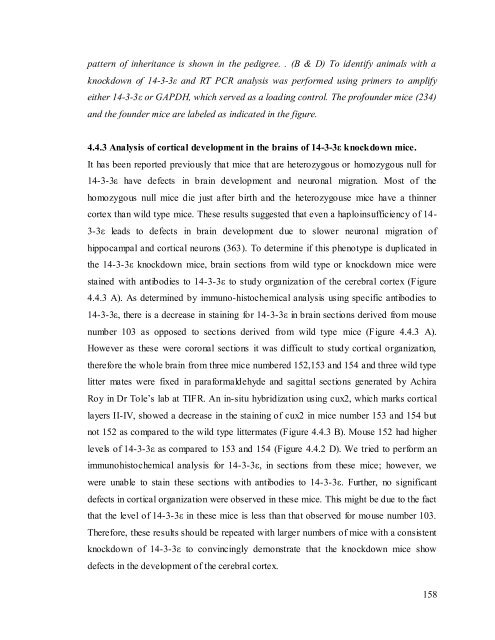LIFE09200604002 Lalit Sehgal - Homi Bhabha National Institute
LIFE09200604002 Lalit Sehgal - Homi Bhabha National Institute
LIFE09200604002 Lalit Sehgal - Homi Bhabha National Institute
You also want an ePaper? Increase the reach of your titles
YUMPU automatically turns print PDFs into web optimized ePapers that Google loves.
pattern of inheritance is shown in the pedigree. . (B & D) To identify animals with a<br />
knockdown of 14-3-3ε and RT PCR analysis was performed using primers to amplify<br />
either 14-3-3ε or GAPDH, which served as a loading control. The profounder mice (234)<br />
and the founder mice are labeled as indicated in the figure.<br />
4.4.3 Analysis of cortical development in the brains of 14-3-3ε knockdown mice.<br />
It has been reported previously that mice that are heterozygous or homozygous null for<br />
14-3-3ε have defects in brain development and neuronal migration. Most of the<br />
homozygous null mice die just after birth and the heterozygouse mice have a thinner<br />
cortex than wild type mice. These results suggested that even a haploinsufficiency of 14-<br />
3-3ε leads to defects in brain development due to slower neuronal migration of<br />
hippocampal and cortical neurons (363). To determine if this phenotype is duplicated in<br />
the 14-3-3ε knockdown mice, brain sections from wild type or knockdown mice were<br />
stained with antibodies to 14-3-3ε to study organization of the cerebral cortex (Figure<br />
4.4.3 A). As determined by immuno-histochemical analysis using specific antibodies to<br />
14-3-3ε, there is a decrease in staining for 14-3-3ε in brain sections derived from mouse<br />
number 103 as opposed to sections derived from wild type mice (Figure 4.4.3 A).<br />
However as these were coronal sections it was difficult to study cortical organization,<br />
therefore the whole brain from three mice numbered 152,153 and 154 and three wild type<br />
litter mates were fixed in paraformaldehyde and sagittal sections generated by Achira<br />
Roy in Dr Tole’s lab at TIFR. An in-situ hybridization using cux2, which marks cortical<br />
layers II-IV, showed a decrease in the staining of cux2 in mice number 153 and 154 but<br />
not 152 as compared to the wild type littermates (Figure 4.4.3 B). Mouse 152 had higher<br />
levels of 14-3-3ε as compared to 153 and 154 (Figure 4.4.2 D). We tried to perform an<br />
immunohistochemical analysis for 14-3-3ε, in sections from these mice; however, we<br />
were unable to stain these sections with antibodies to 14-3-3ε. Further, no significant<br />
defects in cortical organization were observed in these mice. This might be due to the fact<br />
that the level of 14-3-3ε in these mice is less than that observed for mouse number 103.<br />
Therefore, these results should be repeated with larger numbers of mice with a consistent<br />
knockdown of 14-3-3ε to convincingly demonstrate that the knockdown mice show<br />
defects in the development of the cerebral cortex.<br />
158
















